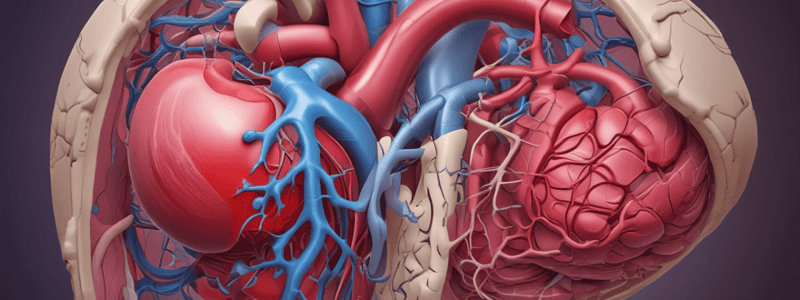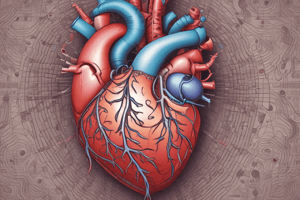Podcast
Questions and Answers
Which of the following valvular abnormalities is associated with a diastolic murmur?
Which of the following valvular abnormalities is associated with a diastolic murmur?
- Aortic regurgitation (correct)
- Aortic stenosis
- Mitral stenosis (correct)
- Mitral regurgitation
What is the most common cause of aortic stenosis?
What is the most common cause of aortic stenosis?
- Degenerative calcific stenosis (correct)
- Congenital
- Rheumatic disease
- Endocarditis
Which of the following factors accelerates the damage to the aortic valve leaflets in degenerative calcific aortic stenosis?
Which of the following factors accelerates the damage to the aortic valve leaflets in degenerative calcific aortic stenosis?
- Hypertension
- Smoking
- Diabetes
- All of the above (correct)
What is the prevalence of congenital bicuspid valve in the population?
What is the prevalence of congenital bicuspid valve in the population?
In which age group is degenerative calcific aortic stenosis most common?
In which age group is degenerative calcific aortic stenosis most common?
What is the result of chronic mechanical stress on the aortic valve leaflets in degenerative calcific aortic stenosis?
What is the result of chronic mechanical stress on the aortic valve leaflets in degenerative calcific aortic stenosis?
Which valve is closed during systole?
Which valve is closed during systole?
What is the characteristic of a systolic murmur?
What is the characteristic of a systolic murmur?
Where is the aortic stenosis murmur best auscultated?
Where is the aortic stenosis murmur best auscultated?
What is the characteristic of aortic regurgitation?
What is the characteristic of aortic regurgitation?
Where is the mitral regurgitation murmur best auscultated?
Where is the mitral regurgitation murmur best auscultated?
What is the characteristic of mitral stenosis?
What is the characteristic of mitral stenosis?
Where is the mitral stenosis murmur best auscultated?
Where is the mitral stenosis murmur best auscultated?
Which valve is not completely closed during diastole in aortic regurgitation?
Which valve is not completely closed during diastole in aortic regurgitation?
What is a common consequence of pulmonary venous congestion in aortic stenosis?
What is a common consequence of pulmonary venous congestion in aortic stenosis?
Which of the following is a right-sided valvular disorder?
Which of the following is a right-sided valvular disorder?
What is the estimated incidence of Acute Rheumatic Fever (ARF) in the US?
What is the estimated incidence of Acute Rheumatic Fever (ARF) in the US?
What is the treatment for mitral stenosis?
What is the treatment for mitral stenosis?
How is aortic regurgitation diagnosed?
How is aortic regurgitation diagnosed?
What is the cause of pulmonary hypertension in mitral stenosis?
What is the cause of pulmonary hypertension in mitral stenosis?
What is the complication of mitral stenosis?
What is the complication of mitral stenosis?
What is the characteristic of a diastolic murmur in aortic regurgitation?
What is the characteristic of a diastolic murmur in aortic regurgitation?
What is the consequence of left ventricular hypertrophy in aortic stenosis?
What is the consequence of left ventricular hypertrophy in aortic stenosis?
What is the characteristic of S4 sound in aortic stenosis?
What is the characteristic of S4 sound in aortic stenosis?
Flashcards are hidden until you start studying
Study Notes
Valvular Heart Disease
- Aortic stenosis: the aortic valve is not completely open, causing difficulty in pumping blood to the aorta during systole.
- Aortic regurgitation: an incompetent/leaky aortic valve allows blood to leak back to the left ventricle during diastole.
- Mitral stenosis: the mitral valve is not completely open, reducing blood flow through the mitral valve during diastole.
- Mitral regurgitation: an incompetent mitral valve allows backflow of blood from the left ventricle to the left atrium during systole.
Cardiac Valves
- Mitral valve: separates the left atrium and left ventricle.
- Aortic valve: separates the left ventricle and aorta.
- Pulmonary valve: separates the right ventricle and pulmonary artery.
- Tricuspid valve: separates the right atrium and right ventricle.
Systole vs Diastole
- Systole: the heart muscle contracts, pumping blood out of the heart.
- Diastole: the heart muscle relaxes, allowing blood to flow into the heart.
- Mitral and tricuspid valves are closed during systole.
- Aortic and pulmonic valves are closed during diastole.
Valvular Abnormalities
- Stenosis: narrowing of the valve, reducing blood flow.
- Regurgitation: backflow of blood through the valve.
Murmurs
- Murmurs are prolonged sounds during systole or diastole due to turbulent flow across abnormally structured valves.
- Systolic murmurs are associated with aortic stenosis and mitral regurgitation.
- Diastolic murmurs are associated with aortic regurgitation and mitral stenosis.
Auscultation
- Auscultation is the process of listening to heart sounds using a stethoscope.
- Aortic stenosis is best auscultated at the right 2nd intercostal space.
- Mitral regurgitation is best auscultated at the 5th intercostal space left midclavicular line.
- Aortic regurgitation is best auscultated at the 2nd intercostal space close to the sternal border.
- Mitral stenosis is best auscultated at the 5th intercostal space left midclavicular line.
Rheumatic Heart Disease
- Rheumatic heart disease is a permanent valvular abnormality that evolves over years following one or several episodes of acute rheumatic fever.
- Acute rheumatic fever occurs 2-3 weeks following strep pharyngitis caused by rheumatogenic types of Streptococcus Group A β-hemolyticus.
- Rheumatic heart disease affects all layers of the heart, including valves, joints, skin, and brain.
Pathologic Changes
- Aortic stenosis leads to increased resistance to flow, left ventricular pressure afterload, and left ventricular hypertrophy.
- Mitral regurgitation leads to increased left atrial volume, backflow of blood to the pulmonary circulation, and pulmonary vascular congestion.
- Aortic regurgitation leads to increased left ventricular end-diastolic volume, left ventricular dilation, and pulmonary vascular congestion.
- Mitral stenosis leads to left atrial enlargement, atrial fibrillation, and pulmonary vascular congestion.
Presentation and Diagnosis
- Aortic stenosis may present with systolic murmurs, angina, syncope, and dyspnea.
- Mitral regurgitation may present with systolic murmurs, dyspnea, palpitations, and S3 sound.
- Aortic regurgitation may present with diastolic murmurs, dyspnea, wide pulse pressure, and bounding pulses.
- Mitral stenosis may present with diastolic murmurs, dyspnea, and atrial fibrillation.
- Diagnosis is made using echocardiography (ECHO) and may involve the detection of valvular abnormalities, left ventricular hypertrophy, and left atrial enlargement.
Treatment
- Aortic stenosis is treated with aortic valve replacement.
- Mitral regurgitation is treated with mitral valve replacement or anticoagulation if atrial fibrillation is present.
- Aortic regurgitation is treated with aortic valve replacement.
- Mitral stenosis is treated with mitral valve replacement or anticoagulation if atrial fibrillation is present.
Studying That Suits You
Use AI to generate personalized quizzes and flashcards to suit your learning preferences.




